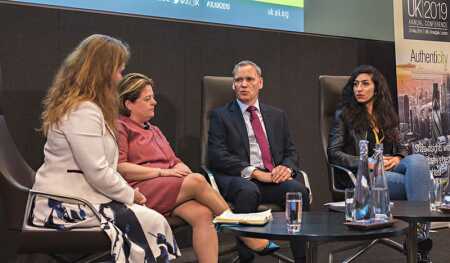
From left to right: moderator Alexandra Notay, Build To Rent Fund director, PfP Capital; Eva Grosman, chief executive, Centre for Democracy and Peace Building; David Warburton, head of land and development, West Midlands Combined Authority; May Al-Karooni, CEO and founder, Globechain, speaking at the ULI U.K. Annual Conference.
At the ULI U.K. National Conference, panelists identified how redevelopment can contribute to building integrated, prosperous communities, drawing examples from Northern Ireland and the United Kingdom’s Midlands.
Eva Grosman, the chief executive of the Centre for Democracy and Peace Building, related a day she had spent in Belfast with a previous president of Finland and a former paramilitary. The point of the anecdote was that while there are still 99 security barriers in Belfast, the psychological barriers that prevent integration are just as important.
“The former president wanted to go and see the peace walls, so I hired a cabbie called Billie—cabbies in Belfast are often ex-paramilitaries,” said Grosman. “After we had finished the tour, we asked Billie to take us to [Northern Ireland’s parliament] Stormont. He was horrified because he had never left north Belfast before. So, it was no longer just a tour for the president; it was a tour for Billie as well. In the end, he joined us for afternoon tea at Stormont.”
David Warburton, head of land and development at the West Midlands Combined Authority (WMCA), agreed that breaking down barriers is critical for building successful places. “We have huge economic and social disparity,” he said. “Nationally, we spend £73 billion [US$92 billion] annually on tackling poverty, which is money that can’t go into other things. It’s a huge issue. We focus on inclusive growth in every decision that we make.”
Critical to the WMCA’s inclusive growth agenda, Warburton added, is the recognition that the public sector can make the best use of its limited funds by targeting them in such a way that they unlock private-sector investment. The quid pro quo is that he expects the private sector to take social responsibility seriously, something that he believes will go a long way in terms of attracting community support for development.
“We appreciate that we need to take the community with us,” said Warburton. “We need people to understand that there isn’t enough public investment available to effect real change, so we need to harness investment from other sources. We need communities to welcome investors so that through partnership and using our assets we can invest in health, education, and so on.”
He added: “We recognize that it’s time for a new conversation between the private and public sectors. We are targeting our investment where it creates opportunities for the private sector. In return, we expect the private sector to deliver social value and community infrastructure to help build an inclusive society. We’ve reached the point where we feel we’re rowing with the tide. The industry understands the importance of social value to building long-term value.”
That was certainly the experience of May Al-Karooni, CEO and founder of Globechain, which helps businesses reduce waste by providing a marketplace for listing unneeded items. All items listed on the organization’s website are free for collection by charities, small to medium enterprises (SMEs), and individuals, thereby serving a social purpose at the same time as reducing the transfer of materials to landfill and benefiting the environment. According to Globechain, 5.1 million kilos have already been diverted from landfill, while savings of around £2 million [US$2.5 million] have been created for charities.
“In the last year, we’ve found that companies have come under pressure from their clients [to be more socially and environmentally responsible], so we’re part of the solution,” said Al-Karooni. “It can be very hard for heads of property and others to justify and we know it’s difficult for big developers. But behavior change is happening, so it’s becoming easier.”
Warburton said that other, less positive trends also could be harnessed to help create more cohesive places. The much-vaunted “death of the high street” is one example. “Previously, there was a push for town centers to be monocultural—that they were all about retail,” he said. “But what we’ve found is that the greater the percentage of retail in a town center, the greater the issue.”
He added: “I see the flight of retail from high streets as an opportunity. We know that there is increasing appetite for alternatives [such as build-to-rent developments]. That can be about bringing people together. Where better to build than in town centers? It can help bring long-term sustainability.”
For her part, Grosman agreed that town centers remain a useful tool for bridging cultural divides—although she admitted that Belfast has a long way to go. “Belfast city center should be shared space, but shopping only attracts people during the day, after which it empties out,” she said. “I lived in the city center and I had to drive get a pint of milk. It was the same to find green spaces.”
However, Grosman added that projects such as the Cathedral Quarter are starting to have an impact. The area is now home to more than 50 cultural organizations as well as numerous bars, restaurants, and hotels. “The Cathedral Quarter is playing an important role in trying to get people to interact,” she said. “The ambition is there, but it’s difficult.”
Such initiatives inevitably require local authorities to play a proactive role in stimulating private-sector investment, said Warburton, but they also need community buy-in if they are to be successful. “It is incumbent on the public sector to get better at understanding market trends and therefore how to seed investment,” he said. “But we also need to get better at engaging communities. We need to move away from the idea that the built environment is just about building things.”




